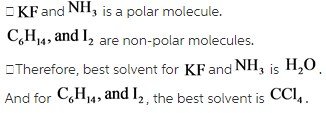For each solute, identify the better solvent: water or carbon tetrachloride. Water, H2O Carbon tetrachloride, CCl4.
Concepts and reason
The concept of “like dissolves like” is used in the question. It means that polar solutes readily dissolve in the polar solvent whereas non-polar solutes dissolve easily in non-polar solvent.
Fundamentals
Electronegativity:
The tendency of an atom to attract a shared pair of electron towards itself is known as electronegativity.
Polar compounds:
If the atoms of the compound have a significant electronegativity difference, then the electron cloud shifts towards the more electronegative atom developing a partial negative charge on itself and a partial positive charge on the other atom. Such compounds are called polar compounds. Example, hydrochloric acid.
Non-Polar compounds: If the compounds do not have much significant difference in their electronegativity, then they are held together by sharing of electrons. Such compounds are called non-polar compounds. Example, benzene.
Answer:
Two solvents are given as ![]() Both show different properties due to the difference in the electronegativity between their atoms.
Both show different properties due to the difference in the electronegativity between their atoms.
Hence, ![]() is a polar molecule and
is a polar molecule and ![]() is a non-polar molecule.
is a non-polar molecule.
![]() contains hydrogen and oxygen atoms which have a significant electronegative difference. Oxygen is more electronegative than hydrogen. Hence, it develops a partial negative charge on itself and inducing a partial positive charge on the hydrogen atom. Therefore,
contains hydrogen and oxygen atoms which have a significant electronegative difference. Oxygen is more electronegative than hydrogen. Hence, it develops a partial negative charge on itself and inducing a partial positive charge on the hydrogen atom. Therefore, ![]() is a polar molecule.
is a polar molecule.
In ![]() ,the electronegativity difference between carbon and chlorine is not very large. Hence, they are held together by covalent bonds and are non-polar in nature.
,the electronegativity difference between carbon and chlorine is not very large. Hence, they are held together by covalent bonds and are non-polar in nature.

The table showing the solvent which is better for each solvent is as follows:


